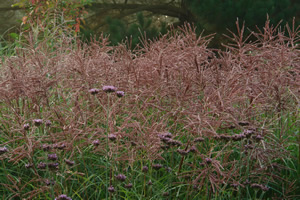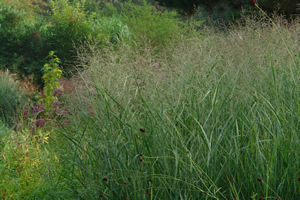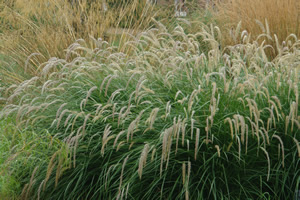|
|
|
Ornamental Grasses - More ‘wow’, less work; using grasses in our gardens Last Updated: 03/01/2012 |
||
|
For many gardeners a slight air of mystery can surround the use of grasses in gardens, but in fact they are deceptively easy to use and are really no different from most perennial plants. While most ornamental grasses prefer open sunny conditions, there are also those that will tolerate dry shade and other difficult to plant situations. Strongly architectural, grasses work well en masse but are just as happy in mixed plantings and need little in the way of aftercare once established. More ‘wow’ with less work is a practical maxim for gardening with grasses. As most of the ‘wow’ factor deciduous grasses come into their own from high summer onwards they are almost uniquely placed to carry the scene right though what can otherwise be a rather barren period in gardens. My own garden at Knoll has a peak of interest from high summer right through until late autumn, though interest continues right up to Christmas and deep into winter.  All of the main groups of deciduous grasses can provide showstopping impact such as miscanthus, pennisetum, panicum, calamagrostis and molinia. For example Miscanthus ‘Ferner Osten’ at about 2metres has fast growing mounds of gently cascading foliage during the earlier part of the season to be followed by masses of dark red flowers that gradually fade to beige; all the while with amazing textural qualities that last far longer than the initial flush of fresh colour. It is just one of many good garden cultivars that reach a peak of performance with the onset of autumn. Miscanthus ‘Flamingo’is a similar height and every bit as good and effective in the garden but with deep bright pink pendulous flowers.  Panicums are a personal favourite. Being a little shorter than the taller miscanthus and so suitable for smaller areas, their generally upright habit and soft leaves which can turn incredible colours in the autumn have spikes of tiny flowers so enthusiastically produced that more solid perennial flowers such as echinacea planted nearby appear to be floating on the cloud like masses of flower. Panicum ‘Heavy Metal’ is well named for its stems leaves and flowers, all of which have a quite tall (1.5m), upright habit, are of a uniform powder blue grey that is so effective with such a wide range of perennials and I enjoy a line of these grasses adjoining groups of Eupatorium maculatum Atropurpureum and Veronicastrum virginicum. Well known for its amazing deep red ‘fall’ colouration and attractively upright habit is Panicum ‘Shenandoah’(1.2m), while a rather new cultivar Panicum ‘Northwind’ (1.2m+), provides a strongly upright accent, flowers well, and has really warm brown autumnal tones.  Fountain grasses (Pennisetum) provide masses of flower at a lower height of generally less than 1metre where their fluffy caterpillar like flowers reflect the slightest amount of morning or afternoon sunshine. This backlit effect is simple to achieve with most of the grasses by simply planting them where the sun will be seen coming from behind the flowers. The effect is magical. Pennisetum ‘Fairy Tails’ is new and rather exciting, with freely produced strongly upright tail like flowers. Pennisetum ‘Red Head’ is a recently introduced unrivalled must have with large initially red flowers that quickly turn to smoky grey-black. Fountain grasses (Pennisetum) provide masses of flower at a lower height of generally less than 1metre where their fluffy caterpillar like flowers reflect the slightest amount of morning or afternoon sunshine. This backlit effect is simple to achieve with most of the grasses by simply planting them where the sun will be seen coming from behind the flowers. The effect is magical. Pennisetum ‘Fairy Tails’ is new and rather exciting, with freely produced strongly upright tail like flowers. Pennisetum ‘Red Head’ is a recently introduced unrivalled must have with large initially red flowers that quickly turn to smoky grey-black. Found in most gardens dry shade is amongst the most difficult of conditions to plant successfully but even here grasses offer several easy care options. Anemanthele lessoniana can cope with the driest shade amongst the roots of trees and shrubs and is as beautiful as it is effective. Where conditions are a little less severe the hakone grass in either the green form Hakonechloa macra or the yellow variegated version Hakonechloa ‘Aureola’ provides elegant mounds of narrow lance shaped leaves that can turn bare dry ground into an oasis of cool. Tags:
ornamental grasses, grass seed, grasses, pampas grass, uk ornamental grass, knoll gardens, perennial grasses, hibiscus, grass ornamental
|